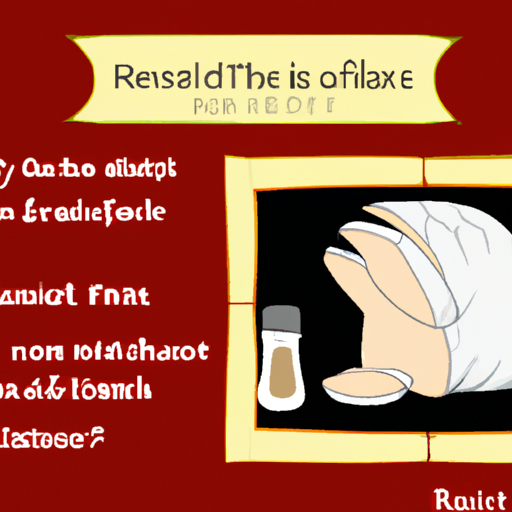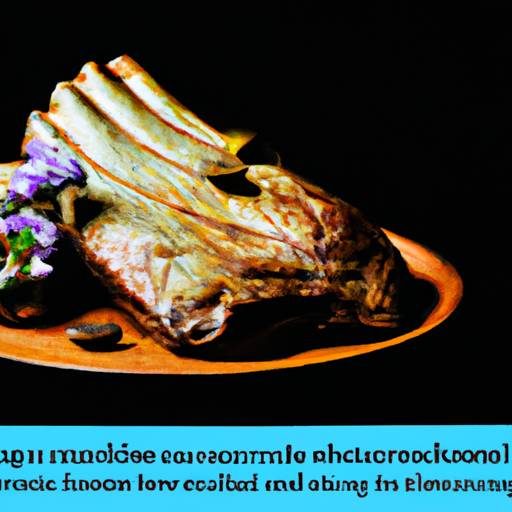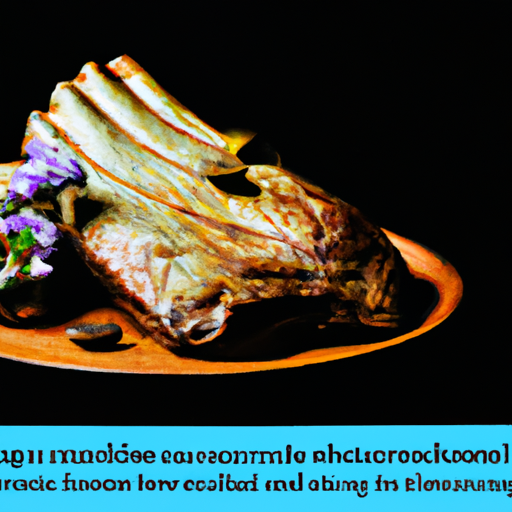You’re about to discover the secret to cooking the most mouthwatering and succulent rib roast you’ve ever tasted. With the “Perfectly Roasted Rib Roast,” achieving a perfectly cooked piece of meat has never been easier. Say goodbye to dry or undercooked roasts and hello to a culinary masterpiece that will have your friends and family begging for seconds. Whether you’re a seasoned chef or a novice in the kitchen, this product will guide you through the cooking process with precise cooking times for a flawlessly cooked rib roast every single time. Get ready to impress with your culinary skills and create a dining experience that will be remembered for years to come.

Perfectly Roasted Rib Roast
Welcome to the ultimate guide on how to perfectly roast a rib roast! Whether you’re planning a special holiday meal or simply want to impress your dinner guests, a beautifully roasted rib roast is sure to be a showstopper. In this article, we will walk you through each step of the process, from choosing the right cut of meat to resting and carving the roast for a perfect presentation. So let’s get started and make your next rib roast a culinary masterpiece!
Choosing the Right Cut of Meat
When it comes to a rib roast, selecting the right cut of meat is crucial for achieving a succulent and flavorful roast. The most popular choice for a rib roast is the prime rib roast, which is cut from the primal rib section of the steer. Prime rib is well-marbled with fat, resulting in a tender and juicy roast.
Selecting a Prime Rib Roast
When choosing a prime rib roast, look for a cut with a generous amount of marbling. The marbling not only adds flavor but also keeps the meat moist during the cooking process. It’s also important to select a rib roast that has a good amount of fat cap on top, as this will help baste the meat and enhance its flavor.
Understanding the Different Grades of Rib Roast
Prime rib roast is available in different grades, including prime, choice, and select. Prime grade rib roast is the highest quality and is well-marbled, making it the most tender and flavorful option. Choice grade rib roast also has good marbling but is slightly leaner than prime. Select grade rib roast is leaner with less marbling, making it a more economical choice, but it may not be as tender or flavorful.
Considerations for Bone-In or Boneless Rib Roast
The next decision you’ll need to make is whether to go for a bone-in or boneless rib roast. Cooking a bone-in rib roast can add extra flavor and moisture to the meat, as the bone acts as a natural heat conductor. Plus, the bone brings an impressive presentation to the table. On the other hand, a boneless rib roast is easier to carve and can be a more practical option if you prefer convenience.
Preparing the Rib Roast
Now that you’ve selected the perfect rib roast, it’s time to prepare it for roasting. Properly preparing the roast will ensure even cooking and optimal flavor.
Trimming Excess Fat
Before cooking, it’s important to trim any excess fat from the rib roast. Leaving a thin layer of fat on the roast will add flavor and help keep the meat moist, but too much fat can result in a greasy final dish. Use a sharp knife to carefully trim the fat, leaving only a thin layer for flavor.
Tying the Rib Roast
Tying the rib roast is an optional step, but it can help the roast maintain its shape during the cooking process. If you choose to tie the roast, use kitchen twine to secure the roast at regular intervals along its length. This will ensure that the roast maintains a uniform shape as it cooks, resulting in even cooking and a more visually appealing presentation.
Bringing the Rib Roast to Room Temperature
Allowing the rib roast to come to room temperature before cooking is an important step that ensures even cooking throughout the roast. Take the rib roast out of the refrigerator at least one hour before cooking and let it sit at room temperature. This will help the roast cook more evenly, preventing the outer portions from overcooking while the center remains undercooked.
Seasoning Options
Seasoning is the key to enhancing the natural flavor of the rib roast. There are several seasoning options to choose from, depending on your personal preference and the flavor profile you want to achieve.
Classic Salt and Pepper Rub
A classic salt and pepper rub is a timeless choice for seasoning a rib roast. Generously season the entire surface of the roast with kosher salt and freshly ground black pepper. The simple combination of these two basic seasonings allows the rich flavors of the meat to shine through.
Herb Crust Rub
If you prefer a more herbaceous flavor, an herb crust rub is a fantastic option. Combine chopped fresh herbs such as rosemary, thyme, and parsley with minced garlic and olive oil to create a flavorful paste. Rub this mixture all over the surface of the rib roast, ensuring that the herbs adhere well.
Spice Rubs and Marinades
For those looking to experiment with bolder flavors, spice rubs and marinades offer endless possibilities. Create a custom spice rub by combining your favorite herbs, spices, and aromatic ingredients. Alternatively, marinate the rib roast in a flavorful mixture of herbs, spices, oil, and acid, such as lemon juice or vinegar, to infuse it with even more flavor.

Marinating vs Dry Rubbing
Once you’ve selected your desired seasoning, you’ll need to decide whether to marinate or dry rub the rib roast. Both methods have their merits, so let’s explore the benefits and considerations of each.
Benefits and Considerations of Marinating
Marinating the rib roast involves soaking the meat in a flavorful liquid for an extended period, allowing the flavors to penetrate the meat. The marinade not only adds flavor but also tenderizes the meat. However, marinating is a time-consuming process, often requiring several hours or even overnight. It’s essential to plan ahead if you choose to marinate your rib roast.
Benefits and Considerations of Dry Rubbing
Dry rubbing involves generously coating the surface of the rib roast with a dry mixture of herbs, spices, and seasonings. Unlike marinating, which requires time for the flavor to infuse, a dry rub can be applied immediately before cooking. Dry rubbing is a convenient option if you’re short on time but still want to add flavor to your rib roast.
Preparing the Roasting Pan
Now that your rib roast is seasoned and ready to go, it’s important to prepare the roasting pan to ensure optimal cooking results.
Choosing the Right Roasting Pan
When selecting a roasting pan, opt for one that is large enough to comfortably accommodate the rib roast without crowding. A roasting pan with a rack is ideal, as it allows hot air to circulate around the roast, resulting in more even cooking. If you don’t have a roasting rack, you can fashion one using a wire cooling rack placed upside down inside the roasting pan.
Adding Flavorful Vegetables and Aromatics
To enhance the flavor of the rib roast, consider placing flavorful vegetables and aromatics in the roasting pan. Chopped onions, carrots, celery, and garlic cloves make excellent additions. These vegetables will not only infuse the meat with their natural flavors but also serve as a flavorful base for making gravy later on.
Roasting Temperature and Time
Roasting temperature and time play a crucial role in achieving a perfectly cooked rib roast. It’s essential to follow recommended guidelines to ensure that your roast is cooked to perfection.
Determining the Cooking Time
The cooking time for a rib roast depends on several factors, including the weight of the roast, desired level of doneness, and the temperature at which you choose to cook it. As a general rule of thumb, plan for about 15-20 minutes of cooking time per pound of meat for a bone-in rib roast, and slightly less for a boneless roast. However, it’s always best to rely on a meat thermometer to determine the roast’s doneness accurately.
Recommended Internal Temperatures
The internal temperature of the rib roast is the most reliable way to determine its doneness. For a medium-rare roast, aim for an internal temperature of 135°F (57°C). Keep in mind that the temperature will continue to rise slightly during the resting period. For a medium roast, aim for 145°F (63°C), and for medium-well, aim for 155°F (68°C). Avoid cooking the rib roast beyond this point, as it can result in a dry and overcooked roast.
Using the Reverse Sear Method
For an extra special touch and even cooking, consider using the reverse sear method for your rib roast. This technique involves cooking the roast at a low temperature first, followed by a quick sear at high heat to develop a delicious crust.
Benefits of the Reverse Sear Method
The reverse sear method offers several benefits, including more even cooking and a perfectly seared exterior. By starting the roast at a low temperature, the meat cooks more evenly from edge to center. The final sear at high heat then adds an irresistible caramelized crust to the roast, elevating its flavor and presentation.
Step-by-Step Guide to Reverse Searing
To reverse sear your rib roast, preheat your oven to a low temperature, around 225°F (107°C). Place the seasoned roast on a roasting rack in a pan and cook it in the low-temperature oven until it reaches an internal temperature of about 10-15 degrees below your desired final temperature. Once the roast has reached this stage, remove it from the oven and set it aside. Increase the oven temperature to 475°F (245°C) and return the roast to the oven for a brief period, just until the exterior develops a beautiful crust. Keep a close eye on the roast during the searing process to prevent it from overcooking.
Basting the Rib Roast
Basting the rib roast throughout the cooking process is a great way to enhance its flavor and juiciness. Basting involves periodically brushing or spooning the pan drippings over the roast, allowing the meat to absorb the flavorful juices.
Why Basting is Important
Basting is important because it helps to keep the rib roast moist and flavorful. As the roast cooks, the fat renders and combines with the seasonings and natural juices, creating a rich and delicious basting liquid. By basting the roast, you continually reintroduce these flavorful juices to the surface of the meat, resulting in a mouthwatering roast.
Simple Basting Tips and Techniques
To baste the rib roast, use a basting brush or spoon to carefully coat the surface of the meat with the pan drippings. Take care not to overdo it, as excessive basting can lead to a soggy crust. Aim to baste the roast every 20-30 minutes, depending on the cooking time, to allow the flavors to develop and penetrate the meat.
Monitoring the Internal Temperature
Throughout the cooking process, it’s essential to monitor the internal temperature of the rib roast to ensure it reaches the desired level of doneness.
Using a Meat Thermometer
A meat thermometer is a valuable tool for accurately monitoring the internal temperature of the rib roast. Insert the thermometer probe into the thickest part of the roast, avoiding contact with the bone, as this can give an inaccurate reading. Keep track of the temperature as the roast cooks, checking it periodically to ensure it doesn’t overcook.
Resting and Carving the Rib Roast
Once the rib roast has reached your desired level of doneness, it’s crucial to let it rest before carving. Resting allows the juices to redistribute within the meat, resulting in a more tender and juicy roast.
Letting the Rib Roast Rest
After removing the roast from the oven, tent it loosely with aluminum foil and let it rest for about 20-30 minutes. This resting period allows the juices to redistribute throughout the roast, ensuring that they don’t flow out when the meat is sliced. It also allows the internal temperature to equalize, resulting in a more evenly cooked roast.
Carving Techniques for a Perfect Presentation
Before carving the rib roast, remove any kitchen twine if you tied the roast earlier. Starting at the bone side, carefully slice the roast into your desired thickness. Aim for thick, uniform slices that showcase the juicy pink interior. Serve the slices on a platter or individual plates, and watch as your perfectly roasted rib roast impresses everyone at the table.
By following this comprehensive guide, you can confidently roast a rib roast that will be a culinary masterpiece. From selecting the right cut of meat to determining the cooking time and seasoning options, every step is essential in creating a tender, flavorful, and visually stunning rib roast. So roll up your sleeves, gather your ingredients, and get ready to wow your family and friends with a perfectly roasted rib roast that they won’t soon forget. Enjoy!
